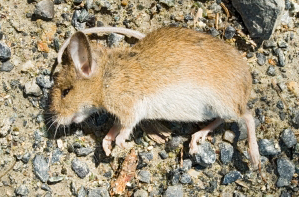Hantavirus
Hantavirus Prevention
- Rodent proof houses, cabins, barns, etc.
- Indoors-use mouse traps baited with peanut butter
- Outdoors-use baits and place in inaccessible areas to children and pets
- Eliminate/reduce harborage and food sources
- Remove litter, brush piles, etc. from yard
- Elevate woodpiles, equipment, etc. above ground and away from house
- Store food and pet food in sealed containers and do not leave pet food out overnight
- Clean up spilled seed from birdfeeders
- Keep garbage in containers with tight lids
- Use precautions when cleaning or working in a rodent infested area
- Use respirator and wear gloves. Respirator should seal tightly to the face and be equipped with a HEPA filter (N-100 NIOSH rating)
- Ventilate closed structure for one to three hours before entering
- Spray carcasses, droppings and nest material with disinfectant -- such as 5 percent Clorox solution, Lysol, etc. -- before disposal
- Cleanup with a mop, sponge or wet-vacuum - Do not sweep or dry-vacuum rodent droppings
- Seal dead mouse and other materials in a plastic bag and discard in outdoor trash can
Human Symptoms
- People are infected by breathing in the virus during direct contact with rodents or from disturbing dust and feces from mice nests or surfaces contaminated with mice droppings or urine.
- The incubation period can vary from one to five weeks but the average is two to three weeks. The early symptoms are similar to the flu, including fever, chills, headache, fever, and muscle aches.
- Initially, there are no respiratory symptoms such as a cough. Within one to five days after the initial symptoms a dry cough, shortness of breath and difficulty in breathing develop. This is the result of fluid buildup in the lungs. From this point the illness can progress very rapidly to pulmonary edema (fluid in the lungs) and respiratory failure. If these symptoms appear, seek medical attention immediately.
- People who live, work, or visit rural areas of the the state are at some risk of exposure. The greatest risk factor is exposure to large numbers of rodents. This is especially true when living in a heavily rodent infested house or exposure to confined spaces infested with mice. Activities associated with risk exposure include cleaning barns, outbuildings, or grain storage areas; cleaning shrubbery; planting; and hand plowing.
Deer Mouse
The deer mouse is 4-9 inches long from head to tail and the color varies from pale gray to reddish-brown with a sharply bi-colored tail. The length of the tail is usually two-thirds of its body length and unlike other field mice, it does not have a tuft of hairs protruding from the tip of the tail.
Other mice such as the pinon mouse and the common house mouse are sometimes mistaken for the deer mouse.

